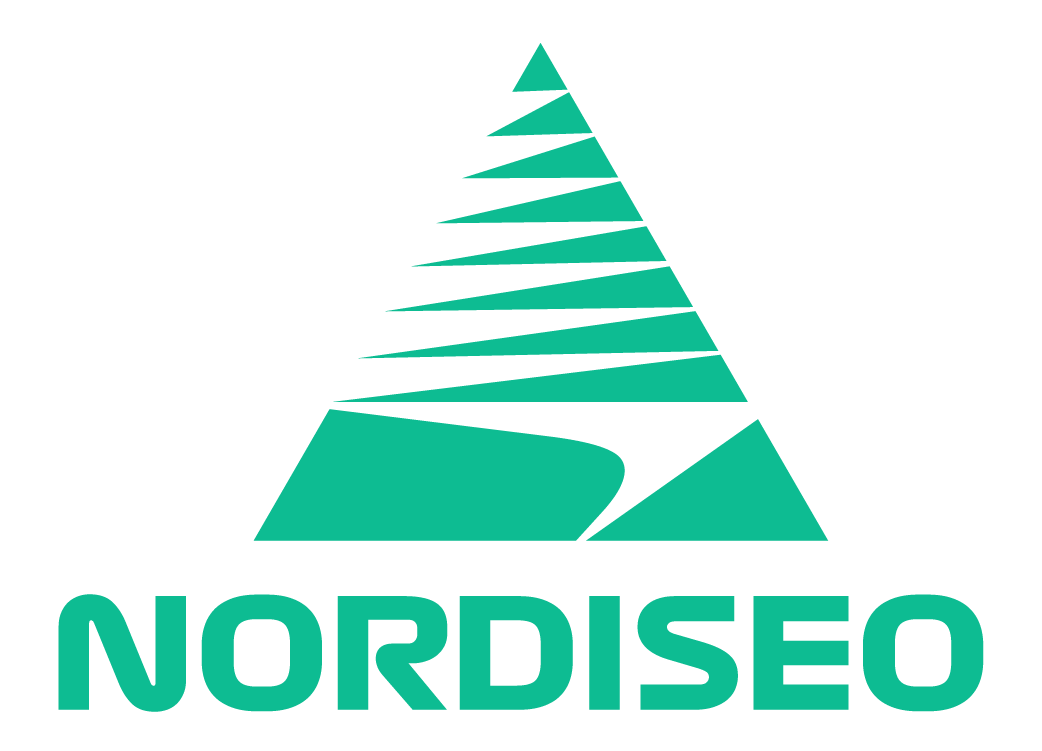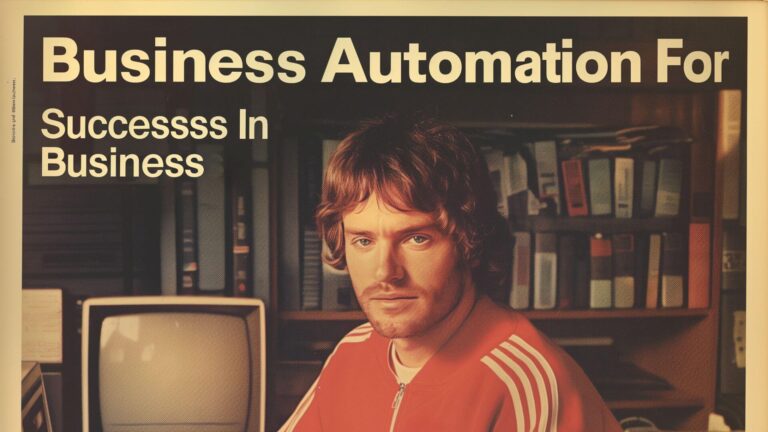It’s clear that automation has become an indispensable tool for businesses aiming to streamline their marketing efforts and enhance engagement. In this guide, we will delve into what marketing automation encompasses, why it’s essential for your marketing strategy, and how to implement it effectively to drive results and ROI.
Whether you’re new to the concept or looking to refine your existing approach, this article provides valuable insights and actionable steps towards optimizing your marketing initiatives for the future.
Let’s learn more, to achieve automation excellence and transform the way you connect with your audience and show your expertise to the world!
| Section | Key Information |
|---|---|
| What is Marketing Automation exactly? | Marketing automation refers to software platforms and technologies that help marketing departments and organizations more effectively market on multiple channels online and automate repetitive tasks. |
| Why Embrace Marketing Automation? | It saves time, increases efficiency, improves customer experience, and helps in aligning sales and marketing goals to drive revenue growth. |
| Getting Started with Marketing Automation | Start by assessing needs and goals, selecting the right platform, integrating marketing channels, personalizing customer experiences, and measuring campaign success. |
What is Marketing Automation exactly?
At its core, marketing automation is all about efficiency and personalization. It involves utilizing various software platforms and technologies specifically designed to streamline complex marketing processes. The idea is to automate repetitive tasks across multiple online channels, ensuring marketers spend less time on manual chores and more time on crafting strategies that resonate with their audience.
For instance, with marketing automation, actions like sending out email campaigns, posting on social media, and segmenting contacts can be executed with precision and without the need for constant human intervention.
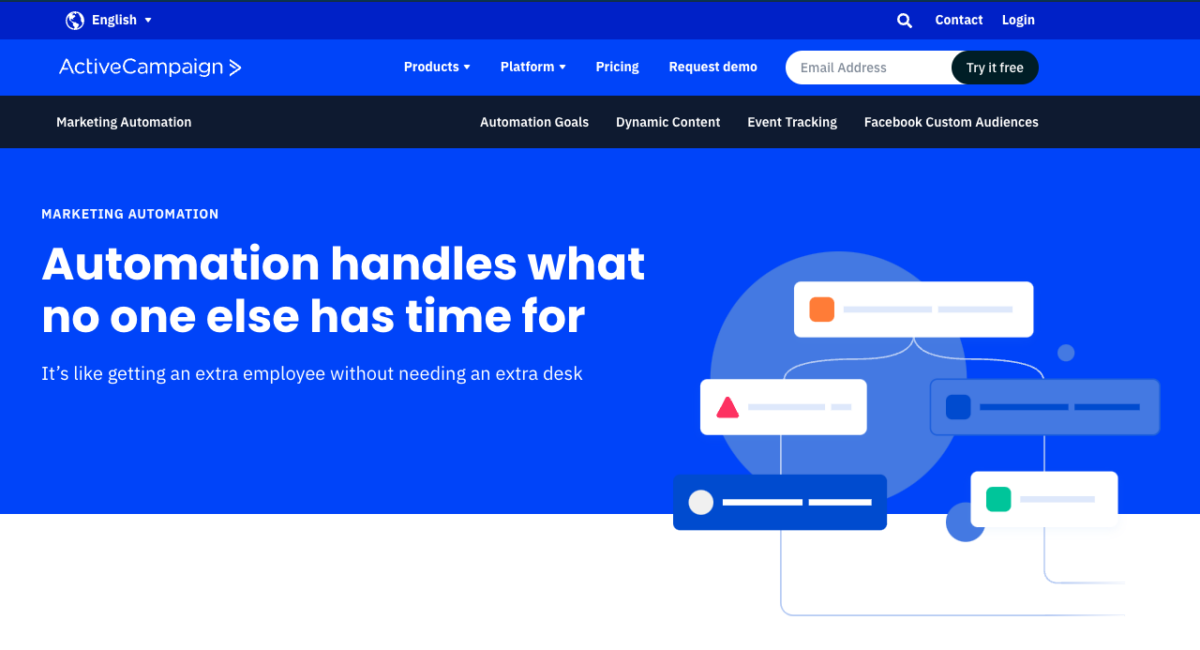
It’s not just about saving time; it’s also about enhancing the ability to engage customers through personalized, relevant communications that can be scaled up as a business grows.
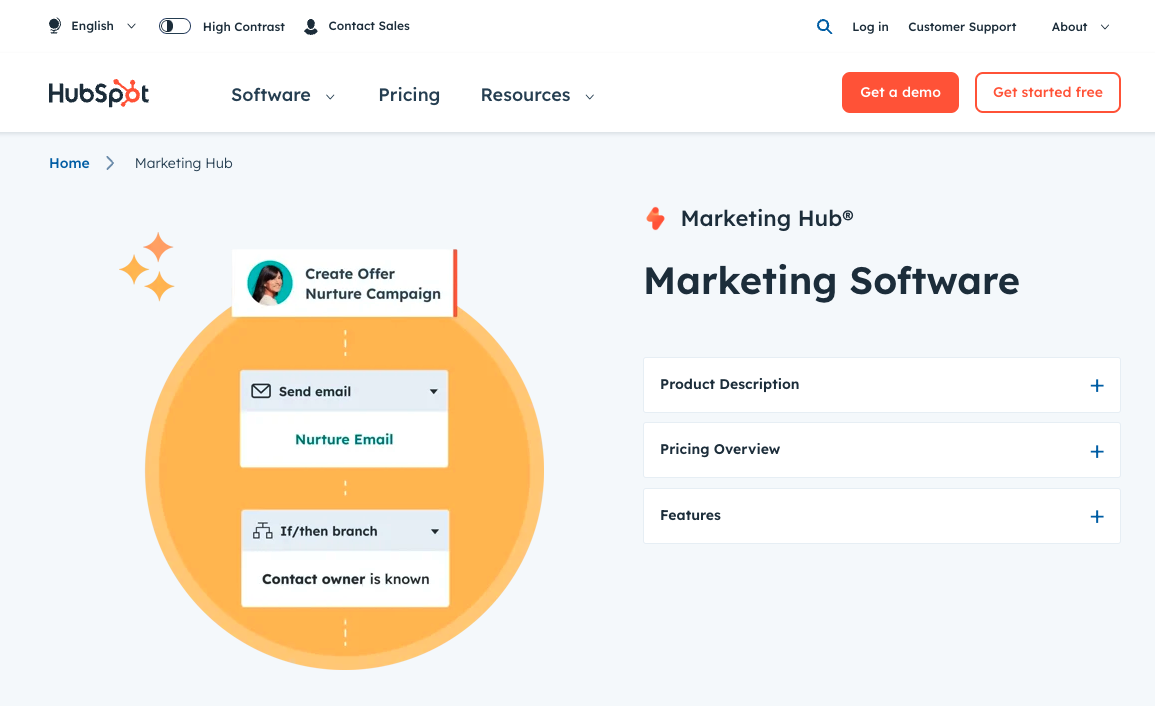
Marketing automation enables companies to track the effectiveness of their campaigns in real-time, allowing for data-driven adjustments that optimize marketing efforts.
Marketing automation isn’t just for large corporations; it’s equally beneficial for small and medium-sized enterprises looking to exploit SEO strategies and other digital marketing tactics without the workload overwhelming their resources.
By automating mundane tasks and organizing customer data, businesses of all sizes can focus on creating meaningful interactions that drive engagement and conversions.

Marketing Automation Strategies for 2024
The strategies set to dominate the marketing automation space in 2024 is essential to keep tabs on for businesses that want to stay ahead of the curve. Embracing Artificial Intelligence (AI) and Machine Learning for more precise targeting positions businesses to connect with their audience like never before.
Engagement is king, and innovative tactics are the ace up the marketer’s sleeve. In 2024, expect to see a surge in sophisticated methods devised to heighten user engagement. This includes but is not limited to:
- Refinement of Ad Targeting:
- AI’s ability to parse through large sets of audience data will continue to evolve, leading to more accurate ad targeting and messaging. Using the ad targeting provided by platforms means decreased with settings optimizations for paid ads marketers.
- Marketers will need to focus on quality and A/B test messaging to meet the higher expectations of increasingly ad-savvy consumers.
- Marketing Automation Evolution:
- AI-powered marketing automation will enable quicker pivots, micro-campaigns, and delivery to smaller segments, meeting the growing demand for hyper-personalized content.
- This technology will allow smaller companies to compete with larger ones by expediting research processes and making more informed decisions.
- Voice-Based Search and Shopping:
- With the rise of voice-based search and shopping, content will need to be optimized for longer-tail keywords that users are likely to ask out loud.
- Marketers should prepare for voice-based payment and shopping to become the norm, as up to 27% of US-based consumers used voice for payment as early as 2022.
- Multimodal AI:
- Generative AI, a form of multimodal AI, will play a significant role in creating content and visuals, offering a more complete user experience. Combining many types of inputs such as visuals and text.
- Predictive Analytics:
- AI will be crucial in predictive analytics, helping marketers foresee market trends, consumer behavior, and campaign effectiveness.
- According to this report with Agency Management Insights 91% of marketing agencies plan to use AI within the next year, with 78% currently using AI tools and 13% preparing to adopt them.
- Machine Customers:
- The concept of “Machine Customers” or “Bot Buyers” refers to automated systems making purchases without human involvement, which will require companies to adapt their strategies.
- Having a dependable and easy to navigate customer journey for both humans and machines will be crucial going forward.
It’s also important to recognize the balance between automation and a personalized touch. Automation strategies should not override the creativity and human insight that drive impactful marketing. Instead, they should complement and amplify these attributes.
It is important to use marketing automation tools in a way that is custom to your brand and always have truly helpful content being shown to relevant people as a goal. Use the data, footprints and descriptions that your company already stores to train/steer tools like generative AI to give you original outputs.
Rasmus Isak Kernen
Marketing Content Creation with AI
AI is revolutionizing marketing content creation, offering a powerful tool to boost efficiency and personalize your outreach. But as mentioned before, we all have to find ways to use it that fits our brand.
Here’s how AI can elevate your marketing content game:
- Content Generation: AI tools can help you brainstorm content ideas, generate outlines, write drafts for various formats (articles, social media posts, emails), and even personalize headlines and product descriptions.
- Content Optimization: AI can optimize your content for search engines by suggesting relevant keywords and ensuring proper structure. This helps your ideal customers find your content more easily.
- Data-Driven Insights: AI analyzes customer behavior and preferences to identify trending topics and content styles that resonate with your target audience. This allows you to tailor your content for maximum engagement.
Remember, AI is a powerful assistant, not a replacement for human creativity. Use it to streamline workflows, generate ideas, and gather insights, but maintain a human touch for the strategic direction and final polish of your content.
I have uploaded a youtube video showing Nordiseos favourite way to generate first drafts for content that we later make articles, social media posts, video scripts and many other types of marketing content with. Here we use Make.com and OpenAI’s GPT4-Turbo API as our tools to set up an AI writer automation specifically for our needs.
You can take a look here:
Leveraging AI and Machine Learning for Precision Targeting
AI-driven analysis not merely guesses but intelligently predicts user behaviors by sifting through large swathes of data at an unprecedented speed and accuracy. This allows for the creation of hyper-personalized marketing campaigns that speak directly to the interests and needs of each consumer.
Imagine tapping into a world where your marketing messages are so targeted, they seem hand-crafted for each recipient. This is the power of AI and Machine Learning in the realm of marketing automation. By leveraging these technologies:
- Marketers can anticipate the customer’s next move and be there with a solution before the need is fully realized.
- Campaigns can run with an increased sense of relevance, appearing in front of users exactly when they are most receptive. As shown by plattforms for PPC such as Meta’s Facebook and Googles Ads.
- Client engagement can transform from broad-strokes marketing to individual conversations at scale, ensuring no opportunity for connection is lost.
As AI continues to evolve, it does so with a learning curve that mimics human intuition, but with the added advantage of computational might. By analyzing past consumer interactions, purchase history, and even social media behavior, AI models extrapolate a user’s future actions.
This enables businesses to tailor their offerings and communication in ways that significantly increase conversion rates. As shown by top level e-commerce plattforms such as Shopify and Alibaba.
AI-driven marketing isn’t just strategic, it’s dynamic. It continuously learns from ongoing campaigns and market trends, effectively optimizing itself in real-time to ensure peak performance. Ensuring that marketers can fokus on making meaningful content instead of adjusting settings for ads targeting.
An example of this is Meta and Facebooks Advantage+ Audience function:

Which after testing has worked well in my campaigns, certainly finding at least the same or even better results then my own targeting.
For companies willing to embrace this technology, the rewards speak for themselves: higher engagement, robust customer retention, and a significant lift in ROI.
Streamlining the Customer Journey with Automation
The essence of an exceptional customer experience lies in a seamless and personalized journey from the first touchpoint through to post-purchase.
By streamlining the customer journey with automation, businesses can craft a pathway that not only attracts prospects but also fosters long-term loyalty.
Automation technologies assist in:
- Eliminating friction points that can lead to customer drop-off.
- Shortening response times to customer inquiries or actions.
- Providing timely and relevant content, recommendations, and offers based on individual customer behaviors and preferences.
One key element in this process is the use of automated triggers. These can initiate certain actions based on predefined customer behaviors, like visiting a website, abandoning a cart, or engaging with an email campaign.
Such triggers can activate personalized email responses, push notifications, or targeted discounts, which align perfectly with where the customer is in their buying journey.
Another important aspect of customer journey automation is the ability to provide a unified approach across all touchpoints.
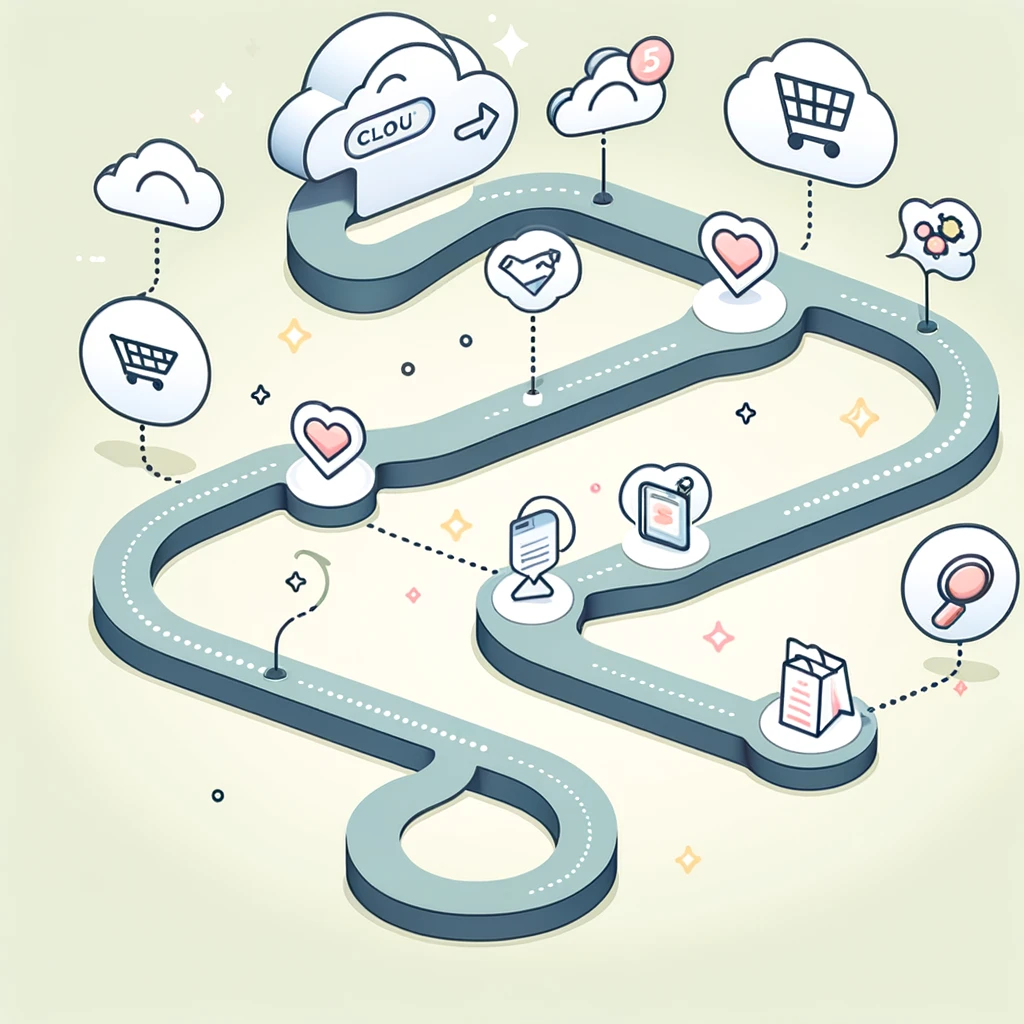
By integrating customer data from various channels into a central platform, businesses gain a 360-degree view of the customer. Such data enables you to deliver a consistent experience, whether the customer is engaging with your brand on a social platform, via a mobile app, or in an email.
To truly leverage automation in streamlining the customer journey, it’s crucial not to lose the personal touch that customers value. Incorporating elements such as personalized greetings and bespoke product suggestions can complement the efficiency of automation.
Innovative tactics for enhanced user engagement
As we venture into an era where user engagement is a critical measure of success, employing innovative tactics has become indispensable.
It is these strategies that captivate the audience, foster interaction and ultimately, convert passive observers into active participants in your brand’s narrative.
Let’s dive into what makes for an engaging strategy:
- Interactivity: Incorporate elements such as quizzes, polls, and interactive videos that invite user input. This not only garners valuable feedback but also increases the time users spend interacting with your brand.
- Personalization: Use data insights to tailor the user experience. From personalized emails to user-specific content recommendations on your website, personal touches can make a user feel valued and understood.
- Gamification: Introduce game-like elements such as reward points, badges, and leaderboards to incentivize engagement. It’s a fun way to encourage users to interact more frequently with your brand.
The key is to create an atmosphere that favors user autonomy, where they feel in control of their engagement with your brand.
This sense of ownership is influential in forging a deeper connection between the user and the brand, ultimately leading to higher levels of engagement.
Marketing technologies now afford us the sophistication to segment audiences and automate personalized content delivery at just the right moments.
Using data-driven storytelling, for instance, can make your brand more relatable and memorable. It’s not just about presenting facts and figures; it’s about weaving those data points into a narrative that resonates with the user on an emotional level.
And when the story is relevant, users listen, engage, and act.

Why embrace marketing automation?
The drive to embrace marketing automation is powered by its ability to save time, boost productivity, and enhance customer engagement. But why should businesses integrate automation into their marketing strategies?
The answer lies in the transformative impact of automation on marketing operations:
- Streamlined Workflow: Marketing automation integrates various marketing tasks into one platform, from email marketing to social media scheduling, ensuring a more organized and less cluttered workflow.
- Time Savings: By automating routine and repetitive tasks, marketers can focus on strategic activities that require human intelligence and creativity.
- Scalability: As your business grows, marketing automation scales with you, handling an increased workload without the need to proportionally increase your staff.
- Consistent Messaging: Automating your marketing ensures that your messaging is consistent across all channels, thus maintaining your brand’s integrity.
- Enhanced Personalization: Utilizing data points collected from customer interactions, marketing automation enables personalized communication at scale, an impossible feat if done manually.
It’s important to note that marketing automation is not about replacing human marketers with robots. Instead, it’s about augmenting your marketing team’s capabilities, giving them the tools to connect with your audience more effectively.
Human Involvement: Despite the heavy lifting done by technology, the strategic direction and decision-making still lie in human hands. Marketers must use their understanding of the brand and its customers to guide the automation process.
Key benefits for streamlined operations and ROI
Marketing automation simplifies complex marketing processes, enabling teams to execute multifaceted campaigns with ease.
This results in a significant reduction in manual labor, freeing up team members to invest in strategic, revenue-generating activities. The reduced need for human intervention also mitigates the risk of human error, thus increasing the overall quality of campaigns.
| Streamlined Operation Benefit | Impact on ROI |
|---|---|
| Automated Workflow Management | Improves efficiency, accelerates market responsiveness, and decreases time to revenue. |
| Data-Driven Campaigns | Enhances customer targeting and personalization directly correlating with conversion uplift. |
| Cost Reduction | Diminishes operational costs, leading to a healthier bottom line. |
| Scalability | Facilitates business growth without needing to excessively expand the marketing team. |
| Comprehensive Analytics | Provides deeper insights into marketing efforts, allowing for better investment decisions. |
With automation tools, not only can businesses measure their campaign performance, but they can also continually optimize their strategies based on real-time feedback.
This ensures that investments are always steered toward the most effective tactics, positively influencing the ROI. The ability to track and measure the success of marketing initiatives in real-time is a critical advantage.
Getting started with marketing automation: 5 Steps to Greater Efficiency
With a structured approach, businesses can deploy marketing automation to enhance efficiency, engage customers, and grow their return on investment.
Overview:
- Step 1: Define Your Marketing Objectives and KPIs – Begin by laying out clear goals for what you wish to achieve with marketing automation. Whether it’s increasing lead generation, driving more sales, or improving customer retention rates, your objectives will guide your choice of tools and strategies.
- Step 2: Choose Your Automation Platform Wisely – Not all platforms are created equal. Consider factors such as ease of use, integration capabilities, scalability, and the level of customer support provided. Select a platform that aligns with your business size, and marketing goals, and can evolve with you as your needs grow.
- Step 3: Integrate Your Channels – To deliver a consistent customer experience, integrate all marketing channels into your automation platform. This ensures seamless interactions with your audience, whether they encounter your brand through email, social media, or your website.
- Step 4: Personalize the Customer Experience – Use audience data to create targeted and personalized campaigns. Automation allows for sophisticated segmentation so you can send the right messages to the right people at the right time.
- Step 5: Measure and Optimize – Finally, use your marketing automation’s analytics to track the success of campaigns against your KPIs. Utilize this data to continually refine and improve your marketing efforts.
Throughout this process, remember that marketing automation is not a set-and-forget solution. Regular maintenance, updates, and a willingness to adapt to new data and market trends will be essential for long-term success.
Step 1: Define Your Marketing Objectives and KPIs
Embarking on the trail of marketing automation begins with a reflective pause to assess your marketing needs and goals.
This foundational step is crucial; it gives direction to your entire automation journey. Consider this as your opportunity to delineate what’s paramount for your marketing team and establish targets that are not only aspirational but also measurable and attainable.
Start by asking key questions:
- What specific marketing challenges are we aiming to resolve through automation?
- Which aspects of our marketing process stand to gain the most from automation?
- How will we measure the success of our marketing automation efforts?
When identifying your goals, refer to the SMART criteria, ensuring that each goal is Specific, Measurable, Achievable, Relevant, and Time-bound. Avoid nebulous objectives.
Clear goals could include increasing email campaign click-through rates, automating lead nurturing processes, or improving the efficiency of social media postings.
Examples:
| Marketing Need | Automation Goal |
|---|---|
| Enhanced Lead Generation | Deploy automated lead scoring and nurturing systems |
| Improved User Engagement | Create personalized content delivery through segmentation |
| Efficient Resource Allocation | Automate repetitive tasks to free up creative bandwidth |
Step 2: Selecting the Right Automation Platform
Selecting the right automation platform is a pivotal move in your marketing automation journey. This step enshrines the effectiveness and scalability of your automated processes for years to come.
Balancing capabilities with usability, the optimal platform should be a catalyst for marketing brilliance, not a hindrance.
When embarking on this selection process, several determinants must be considered:
- Functionality: Examine the features and capabilities of the platform. Assess whether it supports the automation of the tasks your goals require, like email marketing, social media posting, CRM integration, or analytics.
- User Experience: Evaluate how intuitive and user-friendly the platform is. A steep learning curve can hinder adoption and reduce the overall effectiveness of the tool.
- Integration: Ensure the platform can seamlessly integrate with your existing marketing tools and software, creating a cohesive ecosystem for your data and campaigns.
- Scalability: Look for a solution that can grow with your business. It should be able to handle an increase in volume of campaigns, contacts, and complexity without faltering.
- Support and Training: Consider the level of customer support and training resources available. These can be crucial for troubleshooting and enabling your team to leverage the platform to its full potential.
Analyze each contender in the context of your unique business needs. A smaller business might prioritize ease of use and cost-effectiveness (more about Automation in Small Businesses), while a larger enterprise might seek advanced features and extensive integration capabilities.
Let’s illustrate with a comparative overview of some of the biggest automation plattforms out there:
| Tool | Target Audience | Starting Price |
|---|---|---|
| Adobe Marketo Engage | Advanced users, companies | $895/month |
| Oracle Eloqua | Enterprise-level, large companies | $2,000/month |
| Customer.io | Startups, flexibility needed | $100/month |
| Constant Contact | Small businesses, email focus | $12/month |
| HubSpot | Small businesses, all-in-one | Free (Starting at $0/month) |
| Salesforce Marketing Cloud | Companies seeking multi-channel | $1,250/month |
Also, consider participating in free trials or demos whenever available. These can provide valuable hands-on experience, clarifying whether a platform’s reality lives up to your expectations and marketing ambitions. Here are some alternatives to test:
- HubSpot Marketing Hub – HubSpot Marketing Hub is a popular all-in-one marketing automation platform that offers a generous free trial period. With HubSpot, you can create email marketing campaigns, landing pages, manage leads and contacts, and track your marketing performance. Their free plan includes a limited number of contacts and features, but it’s a great way to get started with marketing automation.
- Mailchimp – Mailchimp is a well-known email marketing platform that also offers a free plan. With Mailchimp, you can create and send email newsletters, manage your subscriber list, and track your email marketing performance. Their free plan allows you to send up to 10,000 emails per month to up to 2,000 subscribers.
- ActiveCampaign – ActiveCampaign is a marketing automation platform that is designed for businesses of all sizes. They offer a free 14-day trial of their platform, which gives you access to all of their features. ActiveCampaign is a powerful platform that allows you to create automated email workflows, landing pages, web forms, and more.
- ConvertKit – ConvertKit is a marketing automation platform that is specifically designed for creators. They offer a free plan that allows you to send up to 1,000 emails per month to up to 1,000 subscribers. ConvertKit is a great option for bloggers, podcasters, and other creators who want to build an email list and automate their marketing.
- SendinBlue – SendinBlue is a marketing automation platform that offers a free plan that allows you to send up to 300 emails per day. With SendinBlue, you can create email marketing campaigns, manage your subscriber list, and track your email marketing performance. They also offer SMS marketing and marketing automation features on their paid plans.
Step 3: Integrating Your Marketing Channels
The integration of your marketing channels is a pivotal step in the journey of marketing automation. By creating a unified system for all your channels, you allow data to flow seamlessly, ensuring that every customer touchpoint is tracked and that messaging is consistent across platforms.
With an integrated approach, you’ll be able to deliver a more personalized and cohesive experience to your audience, which is essential for nurturing leads and building a strong brand relationship.
To begin with, take stock of all the channels you’re currently using: email, social media, CRM, content management systems, analytics, and advertising platforms.
Each one contains valuable customer data and engagement metrics that can inform your overall marketing strategy. However, these insights can only reach their full potential when they are synthesized across channels.
Consider the following steps for smooth integration:
- Evaluate Compatibility: Review if your current marketing automation platform can connect with your existing tools or if you need to centralize operations with new integrations or software solutions.
Two options for connecting almost any platform that offers API (which is almost all) to each other are Make.com and Zapier.com. - Set Up Unified Data Management: Centralize your data to build a comprehensive view of your customer interactions. This holistic perspective will empower you to create personalized marketing efforts that resonate.
- Implement Cross-Channel Campaigns: Use the data to synchronize campaigns across different channels. For example, an abandoned cart email can coincide with a retargeting ad, multiplying the chances of conversion.
- Ensure Consistent Messaging: Align your brand voice and messaging across all channels for a consistent and recognizable customer experience. Consistency builds trust and reinforces brand identity.
- Monitor and Optimize: Continuously track performance across channels and make data-driven adjustments to your strategy. This will help in refining your approach and improving ROI.
Step 4: Personalizing Customer Experiences
When consumers feel that a brand understands their specific needs and preferences, they’re more inclined to engage and stay loyal.
Marketing automation serves as a powerful ally in this quest for personalization, enabling brands to tailor their communications and offerings at an individual level.
To truly craft personalized experiences, brands must first gather and analyze customer data. This information provides the insights necessary to segment audiences and design interactions that speak directly to different needs, interests, and behaviors.

The goal is to make each customer feel like the marketing messages they receive are crafted especially for them.
Implementing personalization may involve the following steps:
- Collecting Customer Data: Utilize various touchpoints to gather data on customer preferences, purchase history, and online behavior.
- Segmenting the Audience: Break down your audience into distinct groups based on their shared characteristics or behaviors.
- Creating Targeted Content: Develop messaging and content that resonates with the interests of each segment, increasing relevance and engagement.
- Automating Personalized Campaigns: Set up automated campaigns that deliver the right message to the right person at the right time, using data-driven triggers.
- Measuring Results: Analyze the outcomes of personalized interactions to continuously refine and improve future efforts.
“Personalization is the secret ingredient that turns a good marketing campaign into a remarkable one. By speaking the language of the customer, you foster a sense of belonging and significance that transcends mere transactions.”
Some interesting statistics on Personalization and Marketing Efficiency from this article on mckinsey.com:
- Companies that thrive at personalization earn 40% more money from these activities than the average competitor.
- Personalization can lower acquisition costs by up to 50%, improve revenues by 5 to 15%, and enhance marketing spend efficiency by 10 to 30%.
Step 5: Measuring success and optimizing campaigns
Through marketing automation, businesses possess the tools to track campaign performance meticulously and garner the insights necessary for constant refinement.
This dynamic process involves not only identifying what is working well but also pinpointing areas that require enhancement or reinvention.
Embarking on campaign measurement with marketing automation covers numerous metrics, but to optimize campaigns effectively, consider the following approach:
- Identify Key Performance Indicators (KPIs): Determine which metrics are most closely aligned with your marketing objectives. These may include conversion rates, click-through rates, lead generation numbers, or customer retention rates.
- Gather and Analyze Data: Use your automation platform’s analytics tools to collect data across campaigns. Look beyond surface-level metrics to understand the customer journey and engagement at each touchpoint.
- Benchmark and Compare: Evaluate your performance against industry standards or past campaigns. Consider what success in your context should look like, and use that as your benchmark for comparison.
- Test and Experiment: Implement A/B testing or multivariate testing to explore different campaign variables. This helps in identifying the most effective messaging, design elements, and strategies.
- Iterate and Enhance: Based on insights, make informed changes to improve performance. It’s a continual cycle of learning and development that helps finetune your approach and elevate campaign results.
A crucial advantage of marketing automation is the capability to optimize campaigns in real-time. If a particular message isn’t resonating or a campaign isn’t performing as expected, quick adjustments can be made to steer the direction towards better outcomes.
Examples:
| Campaign Element | Optimization Approach |
|---|---|
| Email Subject Lines | Test variations to increase open rates. |
| Landing Page Layout | Analyze conversion paths to streamline user experience. |
| Ad Copy | Experiment with messaging to enhance click-through rates. |
| Timing of Communication | Adjust broadcast times based on audience engagement patterns. |
Real-world examples of marketing automation success
Real-world examples of marketing automation success are the testaments to its transformative power in the dynamic world of marketing. To provide a tangible understanding of this impact, let’s examine case studies that demonstrate how businesses have leveraged marketing automation tools to drive significant improvements in their marketing KPIs.
Take, for instance, a mid-size e-commerce company that implemented automated email campaigns for cart abandonment. By sending personalized reminder emails triggered by the customer’s action, the company reported a 35% increase in recovered sales within the first three months. These emails were not generic; they reflected the individual’s browsing behavior, offered tailored product suggestions, and even tempted the shopper with limited-time discount codes – all orchestrated through marketing automation.
Another example is a B2B service provider that applied marketing automation for lead nurturing. Through a series of automated educational content and personalized follow-ups, they nurtured their leads over six months. As a result, the provider saw a 50% increase in qualified leads entering their sales funnel. Their success hinged on understanding the customer’s journey and delivering relevant information exactly when it was needed to move the lead closer to a purchase decision.
Not all automation successes are about direct revenue generation, though. Consider a software company that used marketing automation to improve customer onboarding. By automating the delivery of training resources and support messages post-purchase, the company not only enhanced customer satisfaction but also reduced support ticket volumes by 20%. This approach ensured that users felt supported from the outset, leading to positive product experiences and long-term loyalty.
| Company Type | Automation Use | Outcome |
|---|---|---|
| E-Commerce | Cart Abandonment Emails | 35% Increase in Recovered Sales |
| B2B Service Provider | Lead Nurturing | 50% Increase in Qualified Leads |
| Software Company | Customer Onboarding | 20% Reduction in Support Tickets |
5 Recommended Marketing Automation Tools for 2024
The right set of tools can make all the difference in your marketing automation journey. With an array of platforms available, it’s important to choose solutions that meet your distinct business needs while remaining user-friendly and efficient.
Let’s look 5 highly recommended tools that have proven their worth in the realm of marketing automation.
1. Customer.io
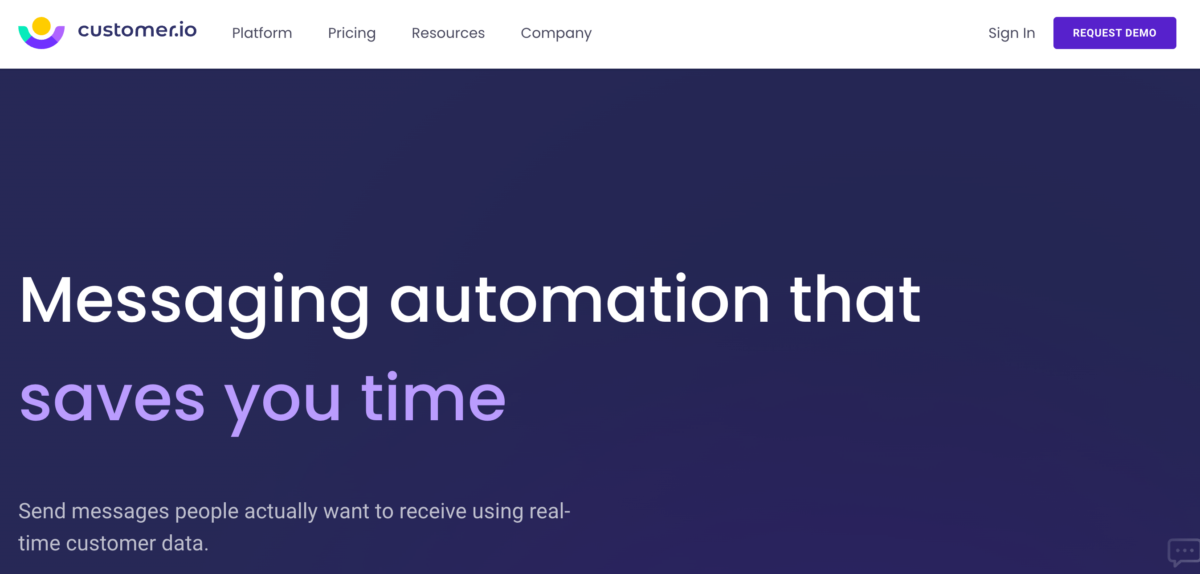
At the heart of personalized marketing is the need for businesses to reach out to their customers with messages that resonate on a deep, individual level. Customer.io emerges as a powerful ally for marketers aspiring to bridge the gap between user data and meaningful engagement.
It stands out in the landscape of marketing automation tools for its finespun capacity to tailor communications based on fine-grained user behavior and profiles.
- Behavior-Driven Messaging: Customer.io’s prowess lies in its segmentation and automation features, which empower marketers to send highly targeted messages triggered by specific user actions, enhancing the relevance of each interaction.
- Flexibility and Integration: The platform boasts compatibility with a multitude of third-party services, granting marketing teams the flexibility to integrate a wide range of data sources and ensure that no valuable user insight slips through the cracks.
- Real-Time Analytics: A distinguishing feature of Customer.io is its real-time analytics, which provide immediate feedback on campaign performance, enabling swift iterations and enhancements to strategy.
Employing Customer.io is not merely about automating emails, it’s about cultivating a dialogue with customers that feels both genuine and timely. Imagine a system that doesn’t just talk at customers, but converses with them, capitalizing on insights gleaned from their interactions to deliver content that’s as relevant today as it will be tomorrow.
2. MailChimp
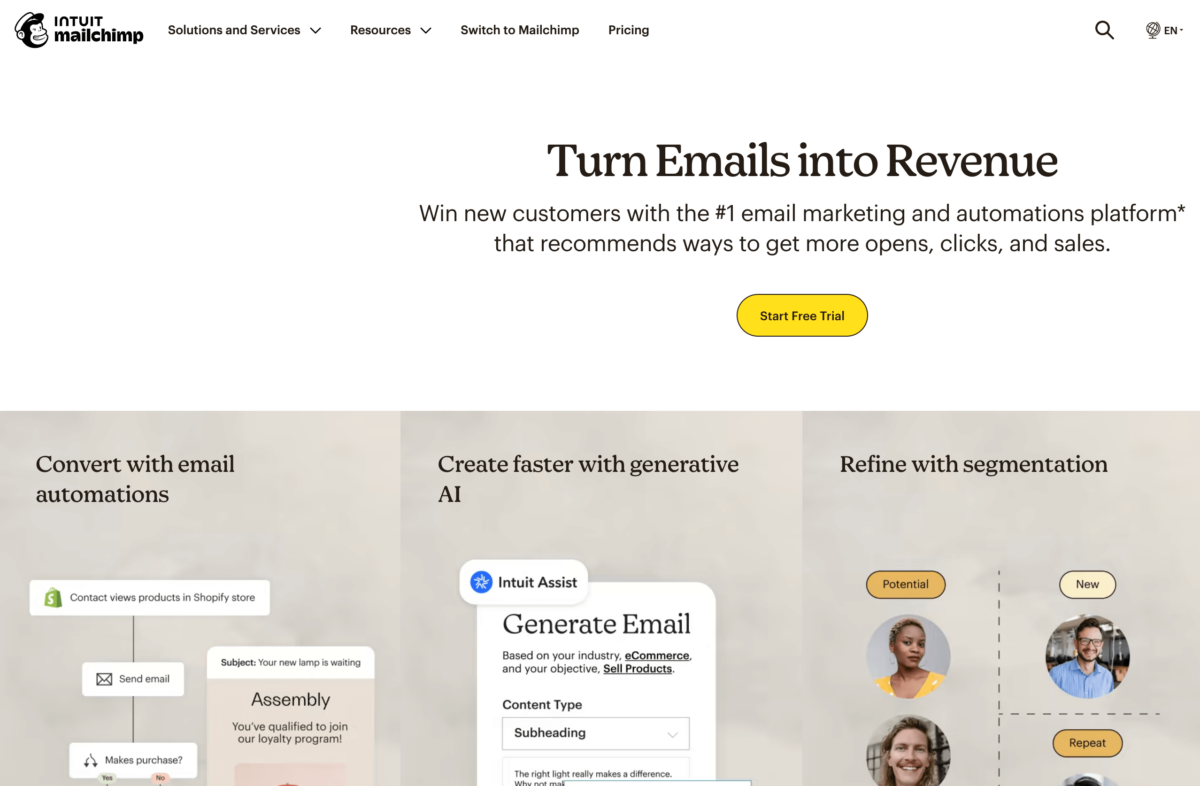
When it comes to marketing automation, MailChimp is often the go-to choice for many businesses, especially small to mid-sized ones.
With its user-friendly interface and comprehensive set of features, MailChimp enables companies to streamline their email marketing campaigns without overwhelming them with complexity.
Key aspects that make MailChimp a favourite include:
- Template Varieties: Offering a diverse range of customizable templates, it empowers even those with minimal design experience to create beautiful, effective emails.
- Automation Capabilities: MailChimp’s automation tools allow for scheduled email campaigns, customer journey mapping, and behavior-triggered messaging.
- A/B Testing: Testing different subject lines and content helps refine the strategy to improve open rates and engagement.
- Analytics: Integral analytics offer insights into campaign performance, equipping marketers with the data to make informed decisions.
Whether you are just getting started with email marketing or looking to refine existing campaigns, MailChimp provides a scalable solution that grows with your business.
Its simplicity does not subtract from its power, making sophisticated marketing accessible to businesses without the need for extensive technical know-how.
3. Hootsuite
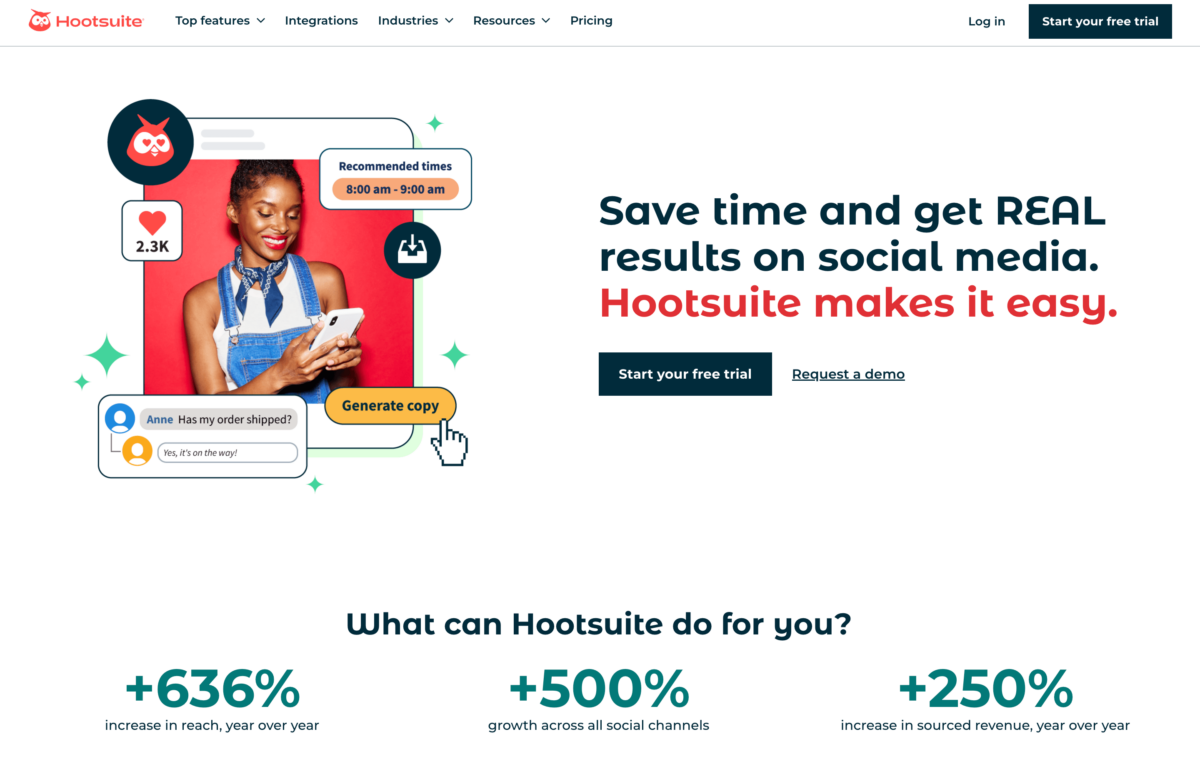
In an age where social media is often the heartbeat of a company’s digital presence, Hootsuite reigns as an indispensable tool for businesses of all sizes.
Hootsuite streamlines the process of managing multiple social media platforms by consolidating them into one comprehensive dashboard. The software’s forte lies in simplifying the complexity of social media management, saving time, and fostering online community engagement.
The functionality that sets Hootsuite apart encompasses:
- Scheduled Posting: Planning and scheduling posts across various social networks ensure consistent online presence without the need for round-the-clock manual updating.
- Monitoring: Keeping an eye on brand mentions, customer feedback, and industry trends is essential for staying proactive and responsive in real-time.
- Team Collaboration: Hootsuite provides a collaborative platform, enabling teams to work together on social content and customer engagement strategies with clear workflows and assignments.
- Performance Analysis: In-depth analytics measure the impact of social media activities, guiding strategy with actionable insights based on data-driven results.
With a robust set of features designed to facilitate effective social media marketing, Hootsuite is a tool that adapts not just to the current need for automation but to the evolving demands of social engagement.
It’s clear that Hootsuite isn’t just about posting content, it’s about cultivating a dynamic dialogue with your audience. Through Hootsuite’s advanced functionalities, cultivating your brand’s social presence becomes an exercise in strategic foresight, ensuring that every Tweet, post, or update is an investment in building stronger relationships with your audience.
4. HubSpot
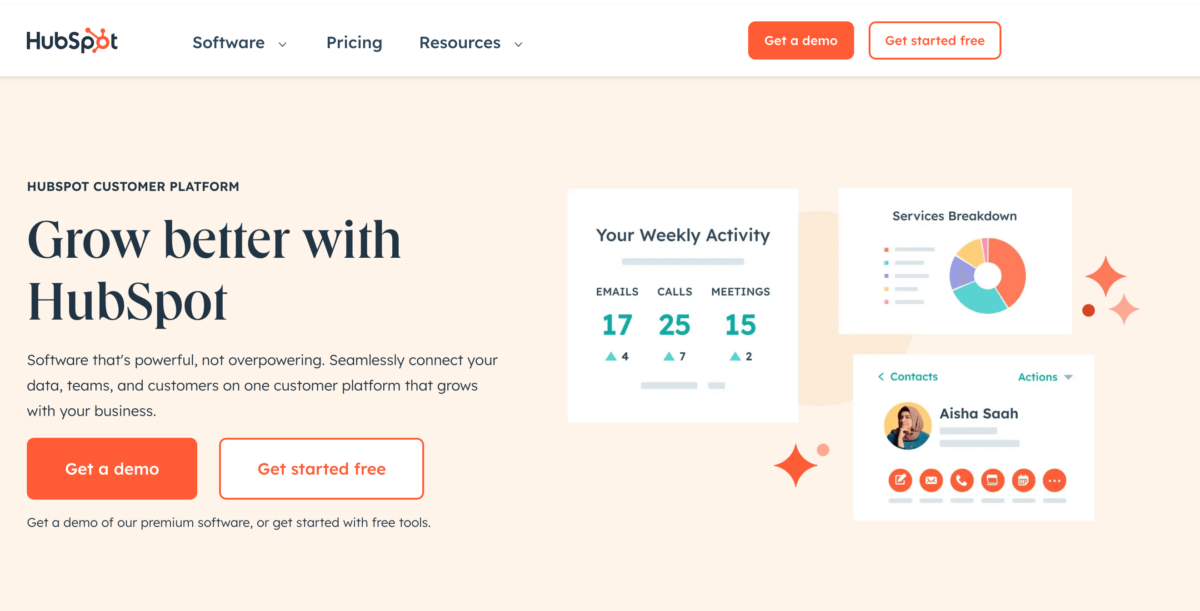
HubSpot is more than just a tool, it’s a comprehensive ecosystem for marketing automation that empowers businesses to engage with their customers throughout the entire journey.
Its all-in-one platform harmonizes marketing, sales, and service departments, allowing for a holistic approach to managing customer relationships.
The core capabilities of HubSpot include:
- Lead Management: Track and nurture leads with personalized workflows and scoring systems that help prioritize follow-ups.
- Inbound Marketing: Create and manage content designed to attract and engage a targeted audience, from blog posts to social media updates.
- Marketing Automation: Automate emails, social media posts, and other tasks to deliver a cohesive message across all channels.
- CRM Integration: Gain in-depth insights into customer interactions through seamless CRM integration, enhancing sales efforts and fostering customer loyalty.
- Analytics and Reporting: Measure the effectiveness of campaigns with comprehensive analytics tools, obtain actionable data, and consistently optimize strategies.
By incorporating HubSpot into your marketing toolbox, you have the power to design an integrated marketing strategy that reaches customers on multiple levels and channels, creating a seamless experience that not only ensures brand consistency but also builds meaningful relationships.
5. Marketo
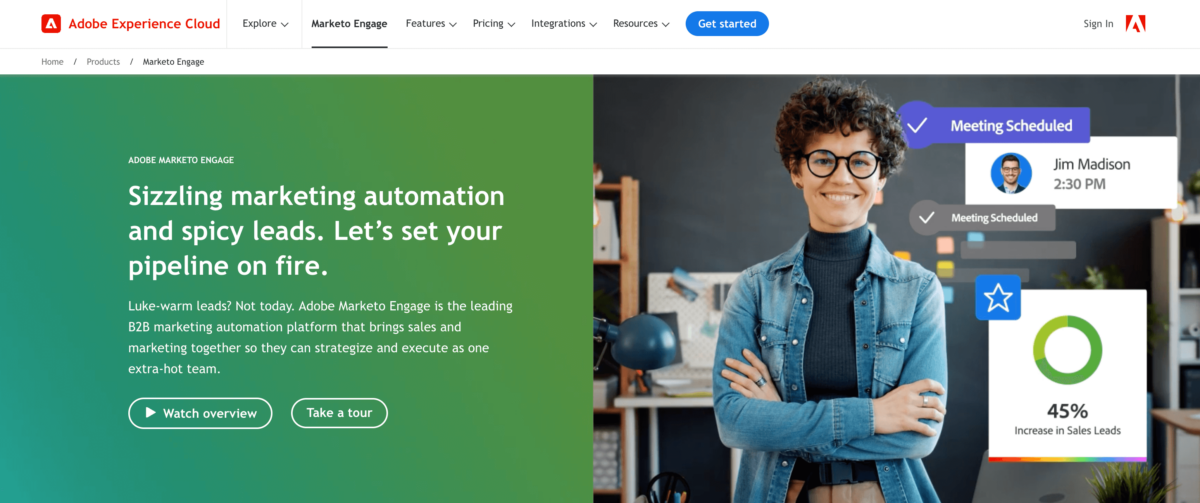
For enterprises endeavoring to craft high-impact marketing campaigns, Adobe’s Marketo Engage stands as a beacon in the realm of marketing automation.
Its distinction lies in the expansive array of customization options and sophisticated features designed to cater to the intricate needs of large-scale operations.
Marketo embraces the complexities of enterprise marketing, offering a solution that’s as robust in functionality as it is in scalability. And of course great integrations with the rest of Adobe’s popular software-library.
A deep dive into Marketo reveals:
- Advanced Lead Management: Marketo shines in nurturing leads through scoring models and lifecycle stages that align with customer behaviors and sales readiness.
- Personalization at Scale: Capitalize on the platform’s ability to personalize interactions based on in-depth insights, delivering messages that resonate on an individual level across large customer bases.
- Robust Integration: Seamlessly integrating with a plethora of third-party applications and CRM systems, Marketo ensures coherence in data and strategy across all facets of marketing and sales.
Employing Marketo’s enterprise-grade solutions empowers marketing teams to deploy, manage, and measure campaigns that are richly layered and targeted with precision.
The platform’s allure is not just in sophisticated automation but also in providing a macro view of the marketing ecosystem, enabling businesses to orchestrate their marketing symphony with both finesse and power.
